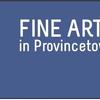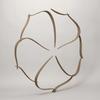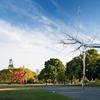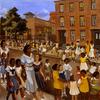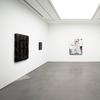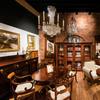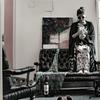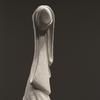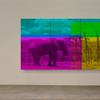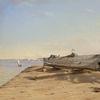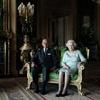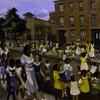Guggenheim Bilbao Brings Together Gerhard Richter Seascapes
- BILBAO, Spain
- /
- May 21, 2019
- Over the course of three decades, Richter created seascapes in different formats, colors, and styles: from abstract seascapes in which the horizon can barely be made out to those in which the photographic realism of the sky is only nuanced by an ambiguous light.
- Shrouded in clouds or totally still, his skies occupy much of the canvas in his seascapes and are only occasionally eclipsed by the sea.
- Richter seeks to create the perfect image and draws from the sky and the sea at different times in an illusory composition in which perspective and light manage to ensnare the viewer.
The Guggenheim Museum Bilbao presents Gerhard Richter. Seascapes, a unique chance (from May 23–September 9, 2019) Guggento view the largest set of his celebrated seascapes ever assembled to date. Richter’s seascapes are not mere depictions of nature. On the one hand, they challenge the viewer’s perception by painting in a way that resembles
photography. Richter manages to achieve an extraordinarily smooth surface by applying highly diluted pigment, and blurs the image, as happens in some snapshots. On the other hand, Richter embellishes the landscape in his quest for perfection: in some works, the sky and the sea actually come from two different
images that he fuses, becoming almost interchangeable and thus leaving the viewer to identify each of them.
Gerhard Richter was born shortly before the outbreak of the World War II in Dresden, which would become a part of East Germany following the end of the conflict. His interest in the Informalism and Expressionism developing on the other side of the Iron Curtain quickly led him to abandon his hometown. In 1961, he moved to Düsseldorf, where he met Sigmar Polke, Blinky Palermo, and Konrad Fischer, among other artists. Even though Richter had made several paintings based on photographs before then, he considered the works he made after 1962 his first photo paintings. In his quest for a “new beginning,” these new works signal a turning point in his career.
At first the sea served as the backdrop for his portraits, shots which come from a family album. These forerunners include beach scenes like Renate and Marianne (Renate und Marianne, 1964), in which he shows his wife and sister-in-law on the sand, or Family at the Seaside (Familie am Meer, 1964), another
blurry family portrait in which the figure of his father-in-law dominates the scene. Shortly thereafter in Deckchair (Liegestuhl, 1964), the human body becomes vaguely hinted at, and viewers are unable to identify the model, as they could in his earlier works. In 1965, he made a small landscape in gray tones merging figuration and abstraction, in what we can perhaps boldly consider his first seascape, Landscape (Landschaft, 1965).
The signature grays of Richter’s works, which stayed with him throughout his entire career and which he defined as “absent of opinion,” are also present in this first work entitled Seascape (Seestück) from 1968, included in the exhibition. This is a small oil on canvas with a clearly horizontal format, as if it had gone
through the anamorphic lenses of a cinemascope. In it, one glimpses an infinite horizon and tiny eddies of what may be white foam, where the materiality of the paint becomes thicker, revealing the artist’s brushstroke. This is a work which could well depict a desert landscape, but the title tells us we are seeing an
ocean, which seems to be enveloped in a diffuse light and an ashen atmosphere.
Three decades and 22 oil paintings on canvas separate this seascape with no figures from the last one that the artist painted in 1998, which is part of the Guggenheim Museum Bilbao Collection. Over these years, Richter presented landscapes in different sizes and formats, colors and styles. Thus, an abstract seascape in which the horizon line can barely be made out is preceded and followed by others in which the photographic realism of the sky is only nuanced by an ambiguous light. Shrouded in clouds or totally still, his skies occupy much of the canvas in his seascapes and are only occasionally eclipsed by the sea.
In Seascape (Wave) [Seestück (Welle)] (1969), which belongs to the collection of The Modern Art Museum of Fort Worth, Texas, two-thirds of the canvas are covered with a stormy sky in varying shades of gray, with light emerging amidst the clouds as if it were a divine manifestation. This effect, most likely due to the fact that the light in the sky does not correspond to its reflection on the sea, was not intentional on the part of the artist, who views light as yet another element of nature. “I was never interested in light. Light is there and you turn it on or you turn it off, with or without sun. I don’t know what the ‘problematic of light’
is” (MoMA interview with Robert Storr, 2002).
In some of his seascapes, Richter starts with a collage of two different photographs, one of the sky and the other of the sea, just as the French researcher and photographer Gustave Le Grey did before him in the 19th century. Richter thus seeks to create a perfect image, using a sky and a sea at different times, in an
illusory composition in which perspective and light have something that ensnares the viewer. These photomontages are recorded in Atlas, the great encyclopedia archive of images that the artist began to compile in the early 1960s and has continued to expand since then. In Seascape (Morning Mood) [Seestück (Morgenstimmung)] (1969), the light that emanates from the horizon line precludes the utter darkness of the ocean. This work, which belongs to the collection of the Musée Départemental d'Art Contemporain of Rochechouart, has the same format and was painted the same year as Seascape (with Olive Clouds) [Seestück (oliv bewölkt)].
While in the former the sky appears blue and cloudless, in the latter it takes on a golden tone conferred by cottony clouds, yet they both share a flatness that seems to erase the painter’s hand. Also from 1969, but in a square format and larger size, are Seascape (Cloudy) [Seestück (bewölkt)] and Seascape (Green-grey, Cloudy) [Seestück (grüngrau, bewölkt)], two totally different landscapes from the Neues Museum Nuremberg and a private collection, respectively.
Many critics have related Richter’s seascapes with the landscape paintings from the 19th-century German Romantic painter Caspar David Friedrich because both artists deal with nature in a similar fashion. Richter himself said in an interview, “I find the Romantic period extraordinarily interesting. My landscapes have
connections with Romanticism: at times I feel a real desire for, an attraction to, this period, and some of my pictures are a homage to Caspar David Friedrich”. (Conversation with Paolo Vagheggi, 1999).
If we compare Richter’s seascapes with Friedrich’s work, especially paintings like his Monk by the Sea (1809), we immediately notice that while both show nature’s sublimity, the monumental scale in Friedrich’s work is evidenced by the addition of tiny figures, while Richter’s seascapes lack any reference that would
reflect the real scale of the landscape. Thus, the size of the canvas is what provides the measure of the seascape to the viewer, who somehow plays the role of the monk.
Among the works in this exhibition, what draws our attention because of its apparent disparity is Seascape (Gray) [Seestück (grau)] (1969). This is a small painting in which the strong abstract brushstrokes make the specificity of the seascape disappear, transforming the work into a monochromatic gray canvas. The gray paints which Richter began to work with in 1967, which he himself said “display the most rigorous illusionism,” are initially canvases in which an abstract work emerges from a concrete one, as if it sought to nullify or perhaps harbor an image. However, the title of the work and the horizon line which can be seen
in the different gray layers brings the viewer back to the seascape.
As if it were the antithesis of the aforementioned work, the exhibition includes a large charcoal work on cotton, Seascape (Seestück, 1970), reminiscent of the first oceans or seas drawn in graphite by the Latvian American artist Vija Celmins. The work lacks a horizon line, as the sea occupies the entire canvas—or
perhaps the sky does—and the viewer does not know where he or she is. A small drawing with 17 seascapes rendered in graphite and pen are displayed next to it, variations on the theme which substitute for the photographs collected in other mediums, such as Atlas.
The last seascape in Gerhard Richter’s career, Seascape (Seestück, 1998) belongs to the Collection of the Guggenheim Museum Bilbao and it marks the closing of the artist’s analysis of this subject. As Richter himself said, these landscapes help him convey his yearnings. “Though these pictures are motivated by the
dream of classical order and a pristine world—by nostalgia, in other words—the anachronism in them takes on a subversive and contemporary quality.”

